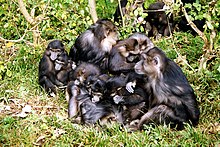Lore Lindu establishes tarsier breeding center

The tarsier, one of the world’s smallest primates, is a combination of sandy-grey and ochre in color. Equipped with long legs, it can leap up to 2 meters. The animal can be found on a number of islands in Indonesia, including Sulawesi, Kalimantan and Sumatra, as well as in the Philippines. People in Central Kalimantan call it the tangkasi.
In other regions, it is called the ghost monkey, the mini-monkey and the small monkey, while it is scientifically known as the Tarsius sp. from the Tarsiidae family.
In Central Sulawesi, especially in the Lore Lindu National Park (TNLL), the tarsier is a target of poaching and is consumed due to its relatively tasty meat. Consequently, its population is dwindling.
“Whereas in fact, the tarsier is the only primate in the world that does not eat leaves, fruit, flowers or other vegetation. It is a carnivore and eats all kinds of insects, such as grasshoppers, crickets and cockroaches, as well as lizards and small birds,” TNLL conservation and technical affairs head Ahmad Yani told reporters at his office recently.
Keeping in mind the dwindling tarsier population, Yani said the park had developed a tarsier breeding center in a protected forest in Kamarora village, Nokilalaki district, Sigi regency, Central Sulawesi.
“But the breeding program is still in the trial phase and has not yielded results,” he said.
Several tarsiers in the program had reproduced before.
In the breeding program, Yani said, the tarsiers’ behavior and mating patterns were observed.
The tarsier, which is endemic to Sulawesi, lives in banyan trees and bamboo. The banyan tree is used as a living and breeding site, while bamboo is a place to play.
“That’s why our breeding center is full of banyan trees and bamboo,” said Yani.
Asked about the tarsier population in the park, Yani said the center did not have precise data but was aware that the population was dwindling due to poaching.
“Our rangers often come across tarsier skulls in the forest,” said Yani.
He said local residents should not regard the tarsier as vermin as it did not destroy crops.
The tarsier stalks and then swiftly attacks its prey, holding it with both hands and pressing down with its feet until it completely overpowers it.
Like other primates, the tarsier is able to grab its victim securely with both hands, each of which has five fingers. It also has 10 toes.
Its middle toes stick out and curve like fangs, thus enabling it to grip its prey. Since it eats various kinds of insects, it is not regarded as a pest by farmers and owners of farms located around the forest.
“So its presence helps farmers because it eats animals that are regarded as pests by farmers,” said Yani.

Ruslan Sangadji, The Jakarta Post, Palu | Archipelago |


3 comments
Everyone loves what you guys are up too. This kind of clever work and exposure!
ReplyDeleteKeep up the good works guys I've incorporated you guys to my personal
blogroll.
Here is my webpage Hermes silk Scarf sale
Hey I know this is off topic but I was wondering if you knew of any widgeets I could add
ReplyDeleteto my blog that automatically tweet my newest twitter
updates. I've beeen looking for a plug-in like thnis for quite
some time andd was hoping magbe you would have some experience with something like this.
Please let mme know if you run into anything. I truly enjoy reading your blog and I look forward to your new updates.
Feel free to surf to my site :: Electronics online usa
ReplyDeleteDistributor Kuota Lampung
PT Lampung Service
Service HP Bandar Lampung
Service iPhone Lampung
Service Acer Lampung
PT Lampung Service
Cv Lampung Service